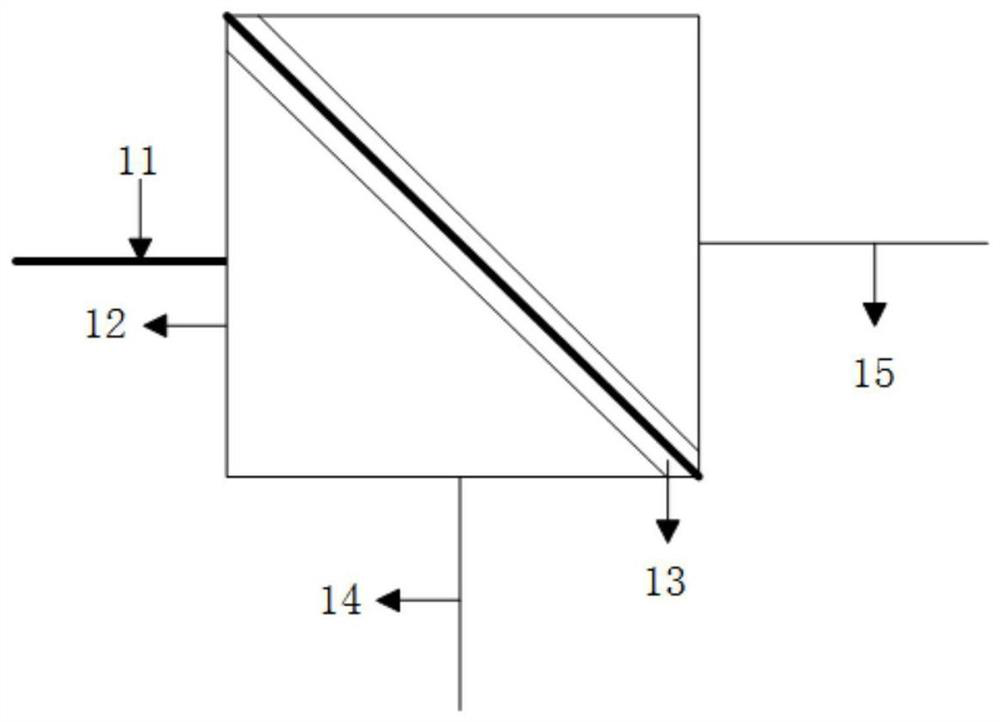Frequency domain quantum weak measurement biomolecule sensor and measurement method thereof
A biomolecule and sensor technology, applied in the field of frequency domain quantum weak measurement biomolecule sensor and its measurement, can solve the problems of difficulty in restoring the optical path state, difficulty in integrating weak measurement methods, etc., and achieves improved sensitivity, improved robustness, The effect of improving stability
- Summary
- Abstract
- Description
- Claims
- Application Information
AI Technical Summary
Problems solved by technology
Method used
Image
Examples
Embodiment 1
[0094] The biomolecular sensor based on differential frequency domain quantum weak measurement provided by this embodiment has a structure such as figure 1 As shown, the sensor includes a light emitting device 1, a polarization state preparation device 2, a phase compensation system 3, a prism and flow channel device 4, a flow channel coupling element 5, a prism replacement device 6, a polarization state selection device 7, and a spectral frequency division device 8 and photodetection element 10. Wherein the light source generator 1 is a semiconductor laser, the polarization state preparation device 2 and the polarization state selection device 7 are both polarization attenuation plates, the phase compensation system 3 is a Soley-Babignet phase compensator, and the prism 4 is a positive triangular prism. The liquid is passed through and contacts with the reflective surface of the prism, the spectral frequency division device 8 is a dichroic mirror, and the photodetection eleme...
Embodiment 2
[0097] This embodiment is based on the quantum weak measurement technology, and the surface plasmon sensor based on the quantum weak measurement provided in Example 1 is used to measure the standard NaCl solution sample. The steps are as follows:
[0098] (SI) Prepare 10 parts of NaCl solutions with a known concentration of 0-1.8% (mass percentage); the solution with a concentration of 0 is deionized water, and it is used as a standard solution.
[0099] (S2) Put deionized water into the sample coupler; turn on the light-emitting device 1, and the light is incident on the polarization state preparation device 2 and the phase compensation system 3 (phase compensation δ≈-1.275rad), so as to satisfy the incident angle of the total reflection condition θ=93.0° is incident on the prism-sample interface, and the reflected light passes through the polarization state selection device 7, and is divided into high-frequency light and low-frequency light by the spectrum frequency division ...
Embodiment 3
[0114] This embodiment is based on the quantum weak measurement technology, and the surface plasmon sensor based on the quantum weak measurement provided in Example 1 is used to measure the binding process of rabbit IgG molecules and protein A molecules. The steps are as follows:
[0115] After standard sample calibration, we can monitor the binding process of biomolecules. Prepare a dopamine solution with a concentration of 2 mg / mL, pH=8.5, and a solvent of 10 mM tris buffer, use phosphate buffer saline as the cleaning channel (PBS, pH7.4), and use bovine serum albumin (BSA) as the blocking solution. In the optical path system in embodiment 2, the binding process of different concentrations of rabbit IgG molecules and protein A is monitored, and the schematic diagram of the test results is as follows Figure 4 shown.
[0116] During the molecular binding test, firstly, a dopamine solution was continuously passed through the flow channel, and a layer of adhesive polydopamine ...
PUM
| Property | Measurement | Unit |
|---|---|---|
| refractive index | aaaaa | aaaaa |
Abstract
Description
Claims
Application Information
 Login to View More
Login to View More - R&D
- Intellectual Property
- Life Sciences
- Materials
- Tech Scout
- Unparalleled Data Quality
- Higher Quality Content
- 60% Fewer Hallucinations
Browse by: Latest US Patents, China's latest patents, Technical Efficacy Thesaurus, Application Domain, Technology Topic, Popular Technical Reports.
© 2025 PatSnap. All rights reserved.Legal|Privacy policy|Modern Slavery Act Transparency Statement|Sitemap|About US| Contact US: help@patsnap.com



